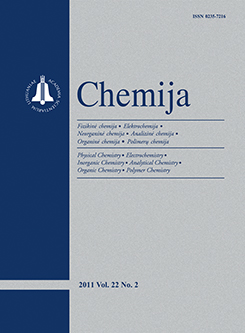 ISSN 0235-7216 ISSN 2424-4538 (online) |
2009 m. Nr. 2 Sorption of chromium complex dye on activated carbon and neutral polymeric adsorbent
The sorption behavior of the anionic chromium complex dye Lanasyn Navy M-DNL from aqueous solution onto activated carbon Norit RB 08.CC (AC) and, as an alternative, the neutral polymeric adsorbent Macronet MN 200 (MN 200) was investigated under various experimental conditions. The sorption properties of both adsorbents depend on their surface functional groups and the electrical charge of the surface net. The adsorption capacity of the polymeric adsorbent MN 200 for the chromium complex dye was found to be relatively higher than that for AC in both acidic and neutral solutions. At the dye solution concentration of 4–80 μmol/l, pH 2 and temperature 293 K, the maximum Langmuir adsorption capacity on AC and MN 200 was found to be 2.46 μmol/g and 3.88 μmol/g, respectively. The sorption capacity for AC and MN 200 strongly depends on solution pH, with higher values at acidic pH. With increasing the solution temperatures from 297 K to 333 K, the sorption capacity for AC decreases and for MN 200 increases. The experimental data showed a good correlation with the Langmuir and Freundlich isotherms models. Using both adsorbents at pH 2, the maximum removal of chromium ions (residual concentration below 1.5 mg/l) and organics (values of chemical oxygen demand below 100 mgO2/l) was obtained when the initial concentration of chromium and organic compounds in dye solution was below 6.16 mg/l and 735 mgO2/l, respectively. The Macronet MN 200 could be employed as an alternative to commercial activated carbon in the removal of metal complex anionic dye from wastewater. Keywords: chromium complex dye, basic activated carbon, hypercrosslinked polystyrene, sorption |
Issues:
2017 - Vol.28 No. 1, No. 2, No. 3, No. 4 2016 - Vol.27 No. 1, No. 2, No. 3, No. 4 2015 - Vol.26 No. 1, No. 2, No. 3, No. 4 2014 - Vol.25 No. 1, No. 2, No. 3, No. 4 2013 - Vol.24 No. 1, No. 2, No. 3, No. 4 2012 - Vol.23 No. 1, No. 2, No. 3, No. 4 2011 - Vol.22 No. 1, No. 2, No. 3, No. 4 2010 - Vol.21 No. 1, No. 2-4 2009 - Vol.20 No. 1, No. 2, No. 3, No. 4 2008 - Vol.19 No. 1, No. 2, No. 3-4 2007 - Vol.18 No. 1, No. 2, No. 3, No. 4 2006 - Vol.17 No. 1, No. 2-3, No. 4 2005 - Vol.16 No. 1, No. 2, No. 3-4 2004 - Vol.15 No. 1, No. 2, No. 3, No. 4 2003 - Vol.14 No. 1, No. 2, No. 3, No. 4 2002 - Vol.13 No. 1, No. 2, No. 3, No. 4 2001 - Vol.12 No. 1, No. 2, No. 3, No. 4 |